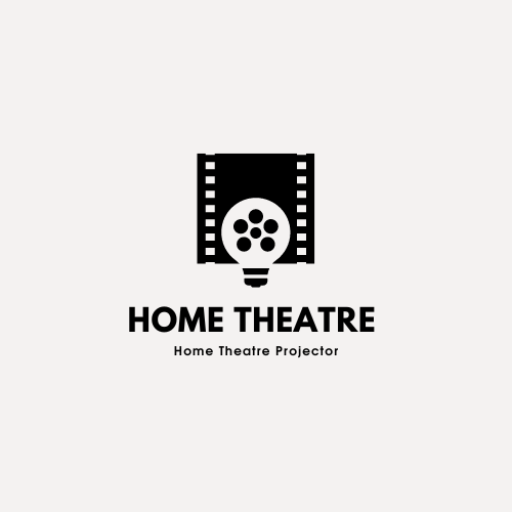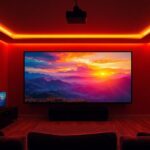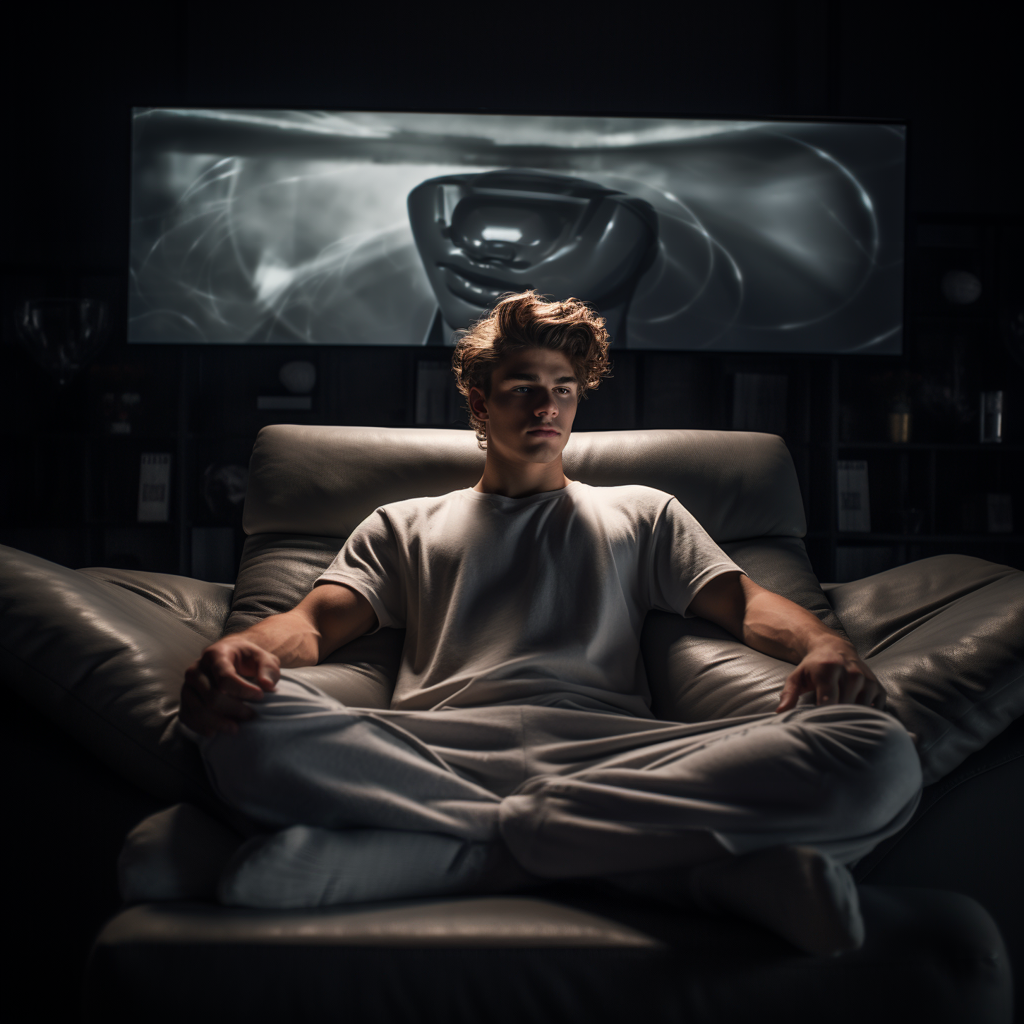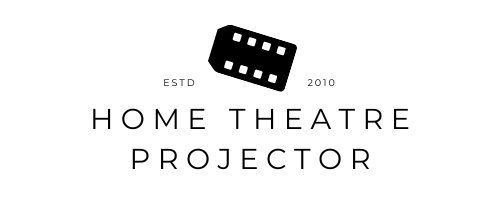Home Cinema
Understanding Video Display Standards: A Simple Guide

Welcome to our comprehensive guide on video display standards. In this article, we will explore the different aspects of video projection, including video resolution, video formats, and display technologies. Understanding these standards is crucial for achieving optimal viewing experiences and ensuring the highest quality and clarity in videos.
Video display standards, such as video resolution and formats, play a vital role in determining the visual aspects of videos. By delving into the details and functionalities of these standards, we can better comprehend how they impact the quality and clarity of video projection. Whether you’re a content creator or a tech enthusiast, this guide will provide you with valuable insights into the world of video display standards.
Key Takeaways:
- Video display standards are essential for achieving optimal viewing experiences.
- Understanding video resolution, video formats, and display technologies is crucial for determining the quality and clarity of video projection.
- Different display technologies, such as LCD, OLED, and QLED, offer varied advantages in video playback.
- Video formats determine how video and audio data are compressed and stored.
- HDMI standards play a crucial role in high-quality video and audio transmission between devices.
The Importance of Video Resolution in Display Standards
Video resolution is a crucial factor in video display standards. It determines the level of detail and clarity in a video, impacting the overall visual experience. Different display technologies support various video resolutions, allowing viewers to enjoy content at different levels of quality. Understanding video resolution is essential for optimizing the viewing experience and making informed decisions when it comes to display technologies.

The Role of Video Resolution
Video resolution refers to the number of pixels that make up the image displayed on the screen. The higher the resolution, the more pixels are available, resulting in a sharper and more detailed image. The most common video resolutions include HD (720p), full HD (1080p), 2K (QHD), and 4K (UHD). With the emergence of 4K resolution, also known as Ultra HD, viewers can now enjoy videos with four times the detail of Full HD. The advancements in display technologies have made it possible to experience videos in stunning clarity and lifelike detail.
Display Technologies and Video Resolution
Different display technologies support various video resolutions. LCD (Liquid Crystal Display) screens, OLED (Organic Light-Emitting Diode) screens, and QLED (Quantum Dot Light Emitting Diode) screens each offer unique features and advantages. LCD screens are known for providing high-resolution images with excellent color accuracy. OLED screens, on the other hand, offer deeper black levels and better contrast, resulting in more vibrant and immersive visuals. QLED technology combines the strengths of both LCD and OLED, delivering bright and vivid images with enhanced color reproduction. These display technologies enable viewers to experience videos in their intended resolution, providing a more engaging and visually pleasing experience.
Enhancing Video Quality with HDR Technology
HDR (High Dynamic Range) technology further enhances video quality by expanding the color gamut and increasing the contrast ratio. HDR allows for a wider range of colors and a greater level of detail, resulting in more realistic and vibrant visuals. It brings out the nuances in both dark and bright areas of a video, creating a more lifelike and immersive viewing experience. HDR technology, combined with higher video resolutions, elevates the overall quality and impact of videos, allowing viewers to enjoy content in unprecedented detail and clarity.
Video resolution plays a vital role in video display standards. It determines the level of detail and clarity in a video, while display technologies and HDR technology further enhance the visual quality. By understanding the importance of video resolution and staying informed about the advancements in display technologies, we can make well-informed choices when it comes to enjoying videos with optimal visual impact.
Table: Comparison of Video Resolutions
| Video Resolution | Pixel Count | Aspect Ratio |
|---|---|---|
| HD (720p) | 1280×720 | 16:9 |
| Full HD (1080p) | 1920×1080 | 16:9 |
| 2K (QHD) | 2560×1440 | 16:9 |
| 4K (UHD) | 3840×2160 | 16:9 |
Understanding Video Formats in Display Standards
Video formats are a crucial component of video display standards. They determine how video and audio data are compressed and stored, influencing the compatibility, efficiency, and quality of video playback. Let’s dive into the different aspects of video formats and understand their significance.
Compression Formats and Codecs
Video formats utilize compression formats, also known as codecs, to reduce the size of video files without compromising quality. Popular compression formats include H.264 (also known as AVC), H.265 (also known as HEVC), and VP9. Each codec has its own strengths and weaknesses, such as efficiency, compatibility, and decoding complexity.
For example, H.264 is widely used for streaming and video playback due to its efficient compression and broad device compatibility. On the other hand, H.265 offers higher compression efficiency but requires more processing power for decoding, making it suitable for newer devices and high-resolution videos. The choice of codec depends on factors such as target device compatibility, bandwidth limitations, and desired video quality.
Container Formats
In addition to compression formats, video formats also utilize container formats to encapsulate video and audio streams into a single file. Container formats provide a standardized structure for storing multimedia data and enable compatibility across different devices and software applications.
Popular container formats include AVI, MP4, MOV, and MKV. Each format supports different combinations of video codecs, audio codecs, and additional metadata. The choice of container format depends on factors such as platform compatibility, desired features, and specific requirements of the target audience.
Choosing the Right Video Format
Choosing the right video format is crucial to ensure optimal playback compatibility and quality. It is recommended to consider factors such as target device compatibility, desired video quality, file size, and intended distribution platforms (such as web or physical media).
By selecting the appropriate video format, compression format (codec), and container format, content creators and video editors can ensure seamless playback across a wide range of devices and deliver the best viewing experience to their audience.

Table: Comparison of Popular Video Formats
| Video Format | Compression Format (Codec) | Container Format |
|---|---|---|
| AVI | Various (including MPEG-4, H.264) | AVI |
| MP4 | H.264, H.265, MPEG-4, VP9 | MPEG-4 Part 14 (.mp4) |
| MOV | H.264, H.265, MPEG-4, VP9 | QuickTime File Format (.mov) |
| MKV | H.264, H.265, MPEG-4, VP9 | Matroska Multimedia Container (.mkv) |
Display Technologies and Their Impact on Video Quality
When it comes to video display, the choice of display technology plays a crucial role in determining the overall quality of the viewing experience. Different display technologies, such as LCD, OLED, and QLED, offer unique benefits and features that can significantly impact video playback.

Table 1: Comparison of Display Technologies
| Display Technology | Advantages | Disadvantages |
|---|---|---|
| LCD (Liquid Crystal Display) | – High-resolution images – Lower cost compared to OLED – Wide range of screen sizes available |
– Limited contrast ratio – Slower response time compared to OLED |
| OLED (Organic Light-Emitting Diode) | – High contrast ratio – Deep black levels for better image quality – Faster response time compared to LCD |
– Higher cost compared to LCD – Limited screen sizes available |
| QLED (Quantum Dot Light Emitting Diode) | – Combines advantages of LCD and OLED – Enhanced color accuracy – High brightness levels |
– Limited availability of screen sizes – Higher cost compared to LCD |
In Table 1, we can see a comparison of the advantages and disadvantages of LCD, OLED, and QLED technologies. LCD screens are known for their high-resolution images and affordable prices, but they have limited contrast ratio and slower response time compared to OLED. On the other hand, OLED screens offer a high contrast ratio and deep black levels, providing better image quality. However, they tend to be more expensive and have limited screen size options. QLED technology combines the advantages of both LCD and OLED, offering enhanced color accuracy and high brightness levels, but it also comes with a higher price tag and limited availability of screen sizes.
Another display technology that has a significant impact on video quality is HDR (High Dynamic Range). HDR technology enhances the color accuracy and contrast ratio of videos, resulting in a more immersive and lifelike viewing experience. By expanding the color gamut and providing a broader dynamic range, HDR brings out details in both bright and dark areas of a video, making it particularly beneficial for content with vivid visuals and captivating cinematography.
Exploring HDMI Standards for Video Transmission
When it comes to transmitting high-quality digital video and audio between devices, HDMI (High-Definition Multimedia Interface) standards are essential. These standards ensure seamless connectivity, allowing us to enjoy our favorite videos with exceptional clarity and sound. HDMI 2.0 and HDMI 2.1 are two commonly used versions that have revolutionized the way we experience video transmission.
HDMI 2.0 is widely adopted and supports various video formats, including 4K resolution, making it perfect for modern high-definition displays. It also offers enhanced audio features, such as support for advanced audio codecs like Dolby Atmos. With HDMI 2.0, we can enjoy immersive sound and stunning visuals that bring movies, games, and other multimedia content to life.
HDMI 2.1 takes video transmission to the next level by providing even higher bandwidth capabilities. It supports up to 8K resolution, allowing for incredibly detailed and sharp images on compatible displays. Additionally, HDMI 2.1 introduces advanced features like Variable Refresh Rate (VRR) and Quick Frame Transport (QFT), which enhance the overall viewing experience, particularly for gaming enthusiasts who value smooth and lag-free gameplay.
| HDMI Standard | Supported Resolutions | Key Features |
|---|---|---|
| HDMI 2.0 | Up to 4K | Enhanced audio support, improved color depth |
| HDMI 2.1 | Up to 8K | VRR, QFT, eARC, enhanced gaming features |
With the continuous advancements in video display technologies and the ever-increasing demand for higher resolutions and immersive experiences, HDMI standards will likely continue to evolve. These standards play a vital role in shaping the future of video transmission, ensuring that we can enjoy our favorite content with the best possible quality and audiovisual performance.
The Advancements and Benefits of 4K Resolution
4K resolution has revolutionized the world of video display with its superior image quality and immersive viewing experience. With four times the pixels of full HD, 4K resolution offers incredibly sharp details, vibrant colors, and enhanced depth. This high level of detail makes 4K ideal for larger screens and cinematic viewing experiences, bringing visuals to life like never before.
One of the main advantages of 4K resolution is the flexibility it provides in video editing. With higher resolution footage, content creators can zoom in, crop, and reframe shots during post-production without sacrificing image quality. This is particularly useful for filmmakers and video editors who want to experiment with different compositions and storytelling techniques.
When combined with the latest display technologies, such as LCD, OLED, and QLED, 4K resolution delivers an even more stunning visual experience. These display technologies ensure precise color accuracy, deep blacks, and high contrast ratios, resulting in breathtaking imagery. Whether you’re watching movies, playing video games, or editing videos, the combination of 4K resolution and advanced display technologies enhances every aspect of your viewing experience.
| Advantages of 4K Resolution | Benefits |
|---|---|
| Sharper details and richer colors | Immersive viewing experience |
| Flexibility in video editing | Zooming and reframing without compromising quality |
| Enhanced visual experience with advanced display technologies | Precise color accuracy and deep blacks |
In summary, 4K resolution is a game-changer in the world of video display. Its exceptional image quality, coupled with advanced display technologies, elevates the viewing experience to new heights. With the ability to capture incredible detail and provide flexibility in video editing, 4K resolution is the preferred choice for filmmakers, content creators, and avid video enthusiasts.

Harnessing the Power of HDR Technology in Video Display
When it comes to video display, HDR (High Dynamic Range) technology is a game-changer. It revolutionizes the way videos are displayed, elevating the visual experience to new heights. HDR enhances color accuracy, brightness, and contrast ratio, resulting in a more lifelike and immersive viewing experience. By expanding the color gamut and providing a broader dynamic range, HDR brings out details in both bright and dark areas of a video, making the content more visually stunning and captivating.
Why is HDR technology so important? The answer lies in its ability to replicate real-world visuals with precision. Traditional display technologies often struggle to reproduce the full range of colors and luminance found in reality. HDR bridges this gap by enhancing the display’s ability to accurately represent the subtleties of light, shadow, and color. This technology enables viewers to see videos as they were intended to be seen by the content creators, allowing for a more immersive and engaging viewing experience.
Not all displays are created equal when it comes to HDR. To fully appreciate the benefits of this technology, it is essential to have a display that supports HDR content. HDR-certified displays offer superior color accuracy, a wider color gamut, and higher contrast ratios, ensuring that every detail of the video is showcased with exceptional clarity and realism. Whether you’re watching a nature documentary, an action-packed movie, or your favorite TV series, HDR technology enhances the visual impact and immerses you in the story like never before.
| Benefits of HDR Technology in Video Display |
|---|
| Enhanced color accuracy |
| Expanded color gamut |
| Improved contrast ratio |
| More lifelike and immersive viewing experience |
As HDR technology continues to evolve, we can expect even more exciting advancements in video display. With the increasing availability and affordability of HDR-certified displays, more viewers can enjoy the immersive experience that HDR offers. From streaming services to gaming consoles, HDR content is becoming increasingly prevalent, providing a richer and more vibrant visual experience. Through harnessing the power of HDR technology, video display is entering a new era of realism and immersion, transforming the way we consume and appreciate visual content.

The Role of Refresh Rate in Video Display Standards
In the world of video display standards, one crucial aspect that directly impacts the quality of the viewing experience is the refresh rate. Refresh rate refers to the number of times per second that a display refreshes its image. It plays a significant role in determining the smoothness of motion in videos, which is essential for creating an immersive and enjoyable viewing experience.
A higher refresh rate, such as 120Hz or 240Hz, results in smoother and more fluid video playback. This is particularly relevant in gaming, where a high refresh rate can greatly enhance the overall gaming experience by reducing motion blur and providing a more responsive and realistic feel. Whether you’re playing fast-paced action games or watching action-packed movies, a higher refresh rate ensures that the visuals remain crisp and clear even during intense scenes.
It’s important to note that the benefits of a higher refresh rate are most noticeable when paired with content that has a high frame rate. For example, a video or game running at 60 frames per second (fps) will appear smoother on a display with a 120Hz refresh rate compared to a display with a 60Hz refresh rate. However, if the content is limited to 30 fps, the difference in smoothness between a 60Hz and 120Hz display will be less pronounced.
| Refresh Rate | Motion Smoothness | Video Playback | Gaming Experience |
|---|---|---|---|
| 60Hz | Good | Satisfactory | Standard |
| 120Hz | Very Good | Smooth | Enhanced |
| 240Hz | Excellent | Ultra-Smooth | Immersive |
As the technology continues to advance, higher refresh rates are becoming more accessible and widespread. Many modern displays, especially those designed specifically for gaming or multimedia purposes, offer refresh rates of 120Hz or higher. So, if you’re looking to upgrade your display for a smoother and more immersive viewing experience, consider a monitor or TV with a high refresh rate to elevate your video playback and gaming experiences to the next level.

The Role of Refresh Rate in Gaming
When it comes to gaming, the refresh rate becomes even more crucial. A higher refresh rate not only improves the smoothness of motion but also reduces input lag, allowing for more responsive controls and quicker reaction times. This can be a game-changer, especially in competitive gaming, where split-second decisions can make all the difference between victory and defeat.
Furthermore, a higher refresh rate can prevent motion blur and ghosting, common issues that can affect the clarity of fast-moving objects in games. With a high refresh rate, you’ll be able to see every detail clearly, even during intense action sequences. This level of visual fidelity can greatly enhance your gaming experience and immerse you deeper into the virtual worlds.
In conclusion, the refresh rate is a vital component of video display standards, particularly in gaming. It directly impacts motion smoothness, video playback, and gaming experience. So, if you’re looking to elevate your viewing or gaming experience, consider investing in a display with a higher refresh rate to enjoy the benefits of smoother motion, reduced motion blur, and enhanced responsiveness.
Understanding Color Gamut in Video Display Standards
Color gamut is a crucial aspect of video display standards, as it determines the range of colors that a display can reproduce. A wider color gamut allows for more accurate and vivid color representation, resulting in a more visually appealing video experience. Two common color gamut standards used in video production and playback are DCI-P3 and Rec. 709.
DCI-P3 is a color gamut standard developed by the Digital Cinema Initiative for digital cinema projection. It offers a wider color range compared to the traditional Rec. 709 standard used for HDTV and Blu-ray. By encompassing a larger color space, DCI-P3 allows for more vibrant and realistic colors, particularly in scenes with rich hues and subtle color variations.
On the other hand, Rec. 709 is a standard color gamut used in broadcasting, home theater, and consumer displays. Although it has a narrower color range compared to DCI-P3, Rec. 709 still provides accurate color reproduction for most general viewing purposes. This standard is widely adopted and compatible with various devices and content, ensuring consistent color representation across different platforms.
| Color Gamut Standard | Description |
|---|---|
| DCI-P3 | A wide color gamut standard used in digital cinema projection, offering vibrant and realistic colors. |
| Rec. 709 | A standard color gamut used in broadcasting, home theater, and consumer displays, providing accurate color reproduction for general viewing purposes. |
When it comes to video display, color accuracy is essential for preserving the intended visual aesthetics and ensuring consistent representation across different devices. By understanding the intricacies of color gamut standards like DCI-P3 and Rec. 709, content creators and viewers can make informed decisions regarding color grading, calibration, and device compatibility, ultimately enhancing the overall video experience.
Aspect Ratio and Its Impact on Video Display
When it comes to video composition and creating a cinematic experience, the aspect ratio plays a crucial role. The aspect ratio defines the proportional relationship between a video’s width and height, shaping the visual composition and the overall viewing experience. Different aspect ratios, such as the commonly used 16:9, the classic 4:3, and the wider 21:9, offer distinct visual aesthetics and are suitable for various screen dimensions and viewing environments.
The choice of aspect ratio can greatly impact the storytelling and visual impact of a video. For instance, the widescreen 21:9 aspect ratio is often employed in cinematic productions to create a more immersive experience, as it fills the entire field of vision. On the other hand, the traditional 4:3 aspect ratio can evoke a sense of nostalgia and is commonly associated with older films and television shows.
Understanding the intended use and target audience of a video is essential in determining the appropriate aspect ratio. For example, if the video will primarily be viewed on mobile devices, a vertical aspect ratio, such as 9:16, may be more suitable to optimize the viewing experience on smaller screens. Alternatively, a square aspect ratio, like 1:1, may be preferred for social media platforms that support square videos.
Table: Comparison of Popular Aspect Ratios
| Aspect Ratio | Common Use | Characteristics |
|---|---|---|
| 16:9 | Most common for televisions, laptops, and online video platforms | Widescreen format, provides a modern and cinematic feel |
| 4:3 | Traditionally used in older television shows and films | Offers a more square-shaped frame, evokes a sense of nostalgia |
| 21:9 | Frequently used in cinematic productions and widescreen monitors | Ultra-wide format, provides an immersive viewing experience |
| 9:16 | Optimized for mobile devices and vertical video platforms | Vertical format, ideal for viewing on smaller screens |
| 1:1 | Square format commonly used in social media platforms | Symmetrical frame, suitable for platforms supporting square videos |
Choosing the right aspect ratio is an important decision for content creators as it can significantly impact the overall visual storytelling and viewer engagement. The aspect ratio sets the stage for the composition and aesthetics of the video, determining how the audience will perceive and experience the content. By understanding the characteristics and common uses of different aspect ratios, content creators can make informed decisions to create captivating videos that resonate with their target audience.
Ultimately, the aspect ratio of a video should be carefully considered to align with the desired artistic vision and the intended viewing platform. It is a powerful tool that can enhance the storytelling and create a more immersive cinematic experience. Whether it’s the wide scope of a 21:9 aspect ratio or the nostalgic charm of a 4:3 aspect ratio, each choice contributes to the overall visual impact and audience connection of a video.

The Future of Video Display Standards
As technology continues to advance at an exponential pace, the future of video display standards holds exciting possibilities. Emerging technologies such as 8K resolution, virtual reality (VR), and augmented reality (AR) are set to revolutionize the way we experience and interact with video content.
8K resolution, with its unprecedented level of detail and clarity, promises to deliver a visually stunning viewing experience. With four times the resolution of 4K, 8K provides a level of realism that immerses viewers into a whole new world of visual storytelling. As 8K displays become more affordable and widely available, content creators will have the opportunity to create breathtaking visuals that captivate audiences.
Virtual reality (VR) and augmented reality (AR) are not just buzzwords; they are technologies that have the potential to redefine the way we consume and engage with video content. VR transports viewers into virtual environments, allowing them to explore and interact with their surroundings in a fully immersive way. AR, on the other hand, overlays digital content onto the real world, enhancing our everyday experiences. From gaming to education, VR and AR have the power to revolutionize industries and create entirely new forms of entertainment.
With the rapid pace of technological advancement, the future of video display standards is undoubtedly an exciting one. As 8K resolution, VR, and AR continue to evolve and become more accessible, the possibilities for immersive and captivating video experiences are endless. From breathtaking visual effects to interactive storytelling, the future of video projection and consumption holds tremendous potential for both content creators and viewers alike.

| Emerging Technologies | Key Features |
|---|---|
| 8K Resolution | Unprecedented level of detail and clarity, four times the resolution of 4K |
| Virtual Reality (VR) | Immersive experiences, transporting viewers into virtual environments |
| Augmented Reality (AR) | Overlaying digital content onto the real world, enhancing everyday experiences |
Conclusion
Understanding video display standards is crucial for achieving an optimal viewing experience. From video resolution and formats to display technologies and aspect ratios, each element plays a vital role in the quality and visual impact of videos. By staying informed about the latest trends and advancements, we can make the most of the ever-changing world of video projection.
As technology continues to advance, video display standards will evolve, providing even more immersive and captivating video experiences. Emerging technologies like 8K resolution, virtual reality (VR), and augmented reality (AR) are shaping the future of video display, offering unprecedented levels of detail, interactivity, and immersion.
By delving into the details and functionalities of video display standards, we can better comprehend how they impact the visual aspects of videos. Whether we are content creators or viewers, staying informed about video display standards ensures that we can take full advantage of the latest technology advancements and enjoy an optimal viewing experience.
FAQ
What are video display standards?
Video display standards refer to the guidelines, resolutions, formats, and technologies that govern the quality and clarity of video projection.
What is video resolution?
Video resolution determines the level of detail and clarity in a video. It is measured in terms of pixels and can vary from standard definition (SD) to high definition (HD) and beyond.
What are the common video resolutions?
Some common video resolutions include HD (720p), full HD (1080p), 2K (QHD), and 4K (UHD). These resolutions offer varying levels of detail and image quality.
What is HDR technology?
HDR (High Dynamic Range) technology enhances the color accuracy, brightness, and contrast ratio of videos. It provides a more lifelike and immersive viewing experience by expanding the color gamut and dynamic range.
Which video formats are commonly used?
AVI, MP4, MOV, and MKV are some of the commonly used video formats. They determine how video and audio data are compressed and stored.
How do display technologies impact video quality?
Different display technologies, such as LCD, OLED, and QLED, offer varying levels of image quality, contrast, and color accuracy. They play a crucial role in enhancing the visual experience of videos.
What is the role of HDMI in video transmission?
HDMI (High-Definition Multimedia Interface) standards ensure high-quality digital video and audio transmission between devices. HDMI 2.0 and HDMI 2.1 are the most common versions used today.
What are the benefits of 4K resolution?
4K resolution offers superior image quality with four times the pixels of Full HD. It provides sharper details, richer colors, and is especially beneficial for larger screens and cinematic viewing experiences.
How does HDR technology improve video display?
HDR technology enhances color accuracy, brightness, and contrast ratio in videos. It brings out details in both bright and dark areas, resulting in a more visually appealing and immersive viewing experience.
What is the importance of refresh rate in video display?
Refresh rate refers to the number of times a display refreshes its image per second. A higher refresh rate, such as 120Hz or 240Hz, results in smoother and more fluid video playback, enhancing the overall viewing experience.
How does color gamut impact video display?
Color gamut determines the range of colors a display can reproduce. A wider color gamut allows for more accurate and vivid color representation, resulting in a more visually appealing video experience.
How does aspect ratio affect video display?
Aspect ratio defines the proportional relationship between a video’s width and height. It influences the visual composition and overall cinematic experience. Different aspect ratios serve different purposes and are suitable for various viewing environments.
What is the future of video display standards?
Emerging technologies such as 8K resolution, virtual reality (VR), and augmented reality (AR) are shaping the future of video display. These advancements offer unprecedented levels of detail, immersive experiences, and exciting possibilities for video projection and consumption.
Source Links
- https://www.dacast.com/blog/video-resolution/
- https://www.dacast.com/blog/video-aspect-ratio/
- https://www.adobe.com/creativecloud/video/discover/video-resolution.html
Tom is the Editor-in-Chief of 1home Theatre Projector, a website that provides news and reviews on the best home cinema experiences. With over 10 years of experience in the industry, Tom knows what makes a great home theatre projector and wants to make it easy for everyone to build the perfect setup for their needs. When he’s not busy writing or testing projectors, Tom enjoys watching classic films and spending time with his family.
Home Cinema
Projector Optics Cleaning and Maintenance: Preserving Image Quality
To ensure vibrant images and extend your projector’s lifespan, discover essential cleaning tips that will keep your optics in pristine condition.
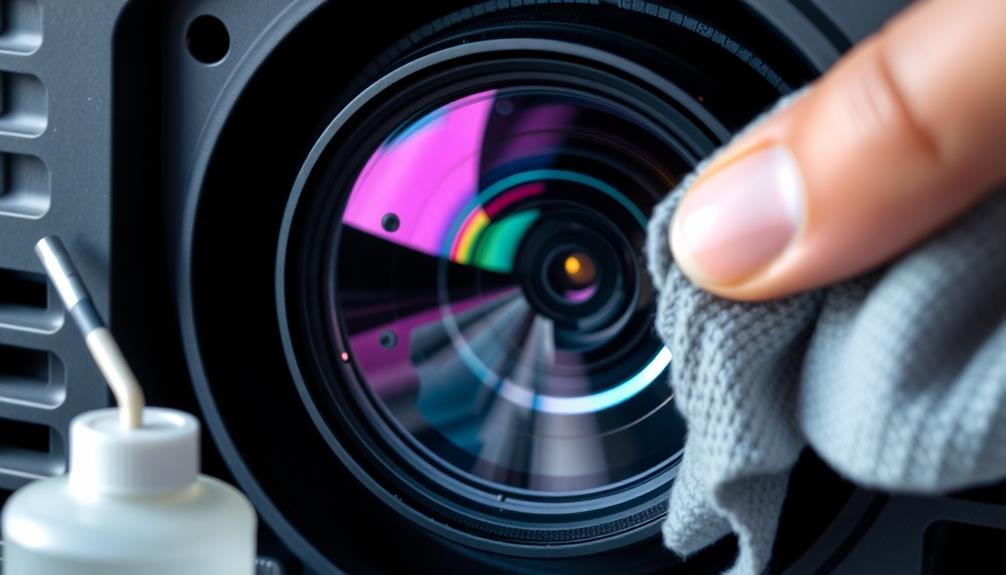
To preserve image quality, you should regularly clean and maintain your projector optics. Start by inspecting the lens for dust and smudges, using a soft brush to dislodge particles. Opt for Kodak lens cleaning paper and a gentle optical cleaner when needed. Avoid harsh chemicals and cotton balls to prevent damage. Regular cleaning not only enhances clarity but also extends the projector's lifespan. Don't forget to maintain the projector case and lamp vents. Effective care prevents dust buildup, ensuring vibrant images. There's much more to explore about keeping your projector in top shape, so you might want to keep going!
Key Takeaways
- Regularly inspect and clean projector lenses using proper tools to prevent dust accumulation and maintain image clarity.
- Employ safe cleaning techniques, such as using microfiber cloths and avoiding direct application of cleaning solutions on lenses.
- Maintain the projector case and exterior by wiping down surfaces and using a vacuum with a soft brush to remove dust.
- Utilize filters and lens caps to protect optics from dust and enhance image quality, ensuring consistent performance.
- Establish routine maintenance schedules to identify and address potential issues early, preserving projector lifespan and image quality.
Importance of Regular Maintenance

Maintaining your projector isn't just a good idea; it's fundamental for getting the most out of your investment. Regular maintenance, particularly cleaning the lens and external components, plays a significant role in enhancing performance and extending the lifespan of your device.
When you perform routine inspections, you can quickly identify dust accumulation and other potential issues before they start affecting image quality.
Proper care practices are essential. Using the right cleaning materials and techniques helps you avoid damaging sensitive lens coatings and internal components.
The cleaner your environment, the less often you'll need to clean your projector. A dust-free space not only allows for ideal image clarity but also contributes to the longevity of your equipment.
Don't underestimate the benefits of scheduled professional servicing. Having experts handle internal cleaning guarantees that all components remain in excellent condition, leading to consistent image quality over time.
Essential Cleaning Tools
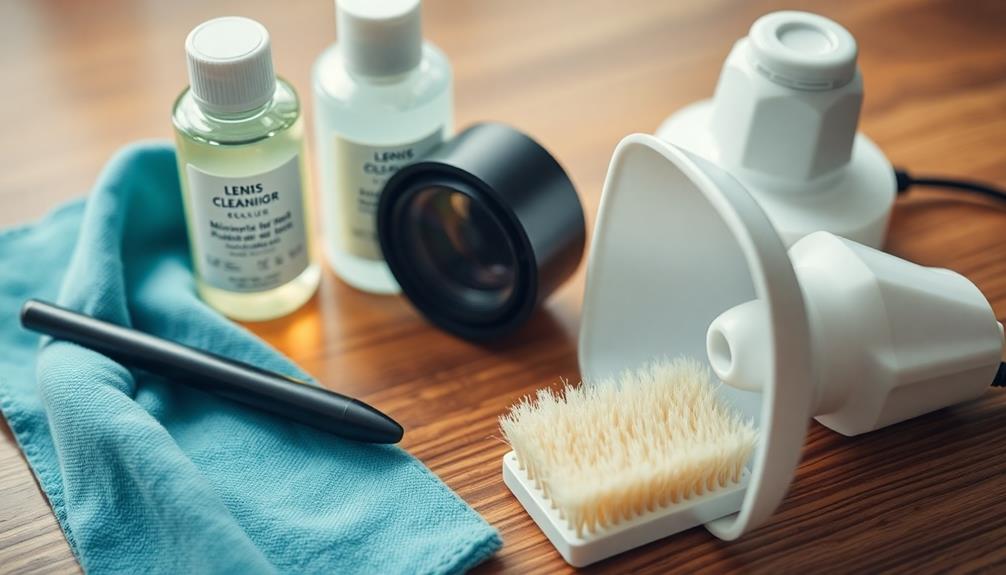
To keep your projector lenses in top shape, you'll need the right cleaning tools.
Using Kodak lens cleaning paper, a versatile lens pen, and microfiber cloths can make a significant difference in maintaining clarity.
Don't forget to have soft brushes and specialized cleaning solutions on hand for those tougher smudges.
Recommended Cleaning Supplies
Keeping your projector lenses clean is essential for ideal performance, and having the right cleaning supplies makes all the difference. To maintain your projector lens in top condition, consider these recommended cleaning supplies:
- Kodak lens cleaning paper: This option minimizes scratches compared to other materials, ensuring a safer clean.
- Soft cloths or microfiber cloths: Perfect for gentle dusting, these materials help maintain the lens surface without causing damage.
- Lens pen: Designed for optical surfaces, this tool provides dual functionality for dust removal without direct contact with the lens.
For stubborn smudges, high-purity alcohol or professional cleaning solutions can be effective, but for regular use, pure water is often the safer choice.
You'll want to avoid using cotton balls or harsh chemicals, as these can leave fibers or residues that might harm the lens coating, ultimately affecting image quality.
Safe Cleaning Techniques
Proper cleaning techniques are just as important as having the right supplies when it comes to maintaining your projector's performance. Start by using a soft brush, like a 0.5 mm brush, to gently dislodge any dust particles on the lens. This step's vital because it prevents scratches before you use any cleaning solution.
When you're ready to lens clean, opt for Kodak lens cleaning paper and a solution specifically designed for optical surfaces. These products effectively remove smudges without risking damage. After brushing, use an ultra-microfiber cloth to wipe the lens gently. Unlike traditional materials, ultra-microfiber reduces the chances of lint and scratches.
Avoid using cotton balls with liquids, as the fibers can stick to the lens surface. Always apply cleaning solutions to your cloth rather than directly onto the lens to prevent pooling, which can cause damage.
For stubborn residues, you might consider using isopropyl alcohol (IPA) sparingly and only when absolutely necessary. Excessive use can harm the lens coating, compromising your projector's image quality.
Step-by-Step Lens Cleaning

Cleaning your projector lens is vital for maintaining ideal image quality and performance. Follow these simple steps to guarantee your lens stays in top condition.
- Inspect the lens: Look for visible dust or smudges. Use compressed air to gently dislodge any loose particles.
- Moisten the cleaning material: For stubborn smudges, dampen lens-cleaning paper or a soft microfiber cloth with distilled water or a recommended lens cleaner.
- Clean gently: Apply the damp cloth in a gentle circular motion, avoiding cotton balls or abrasive materials that could scratch the lens.
Before cleaning, make sure the lens has cooled for at least 30 minutes.
After you've cleaned it, allow the lens to air dry completely before reassembling or using the projector. This step is essential to prevent moisture buildup that could compromise performance.
Regular maintenance is key, so schedule light cleaning routines at least once a month.
This helps maintain lens clarity and prevents dust accumulation that could impact your image quality.
Maintaining the Projector Case

When it comes to maintaining your projector case, start by powering off and unplugging the device for safety.
Use a soft cloth to wipe down the exterior and keep dust at bay, and for tough stains, a damp cloth with mild detergent will do the trick.
Regular cleaning not only keeps your projector looking good but also helps it run smoothly for years to come.
Exterior Cleaning Techniques
Maintaining the projector case is essential for guaranteeing both its longevity and performance. Start by powering off and unplugging the projector to prevent any electrical hazards. Use a soft cloth to gently wipe the surface of the lens and the projector case, removing surface dust. If you encounter stubborn stains, a damp cloth with neutral detergent will work wonders without damaging the finish.
To keep your projector in prime shape, consider these cleaning techniques:
- Wipe down the projector case regularly to keep it dust-free.
- Use a vacuum with a soft brush attachment to clean the vents and guarantee maximum airflow.
- Avoid harsh chemicals like alcohol or wax, as they can damage the material.
Keep an eye out for any dust on the lens, as it can affect image quality. Establishing a routine cleaning schedule will help maintain a dust-free environment around your projector.
Don't forget to check the lens cap, too, to guarantee it's clean and ready for use. By implementing these techniques, you'll preserve the performance and lifespan of your projector.
Dust Prevention Strategies
How can you effectively keep dust at bay and protect your projector? Start by regularly wiping the exterior of your projector case with a soft cloth. This simple cleaning routine removes surface dust, preventing it from entering the internal components and affecting image quality.
When your projector isn't in use, store it in a clean, dust-free environment. This greatly reduces the likelihood of dust settling on the case and lens.
Additionally, use a vacuum with a soft brush attachment to clean the vents. This maintenance step prevents dust buildup that could impact internal cooling and overall performance.
Be mindful of where you place your projector. Avoid high foot traffic areas and locations near open windows, as these conditions can increase dust exposure.
Care for Lamp Vent Screens

Care for Lamp Vent Screens
Regular care for lamp vent screens is vital to keep your projector running smoothly and efficiently. Neglecting these screens can lead to debris buildup, which impacts airflow, projector performance, and ultimately, image quality.
Proper maintenance is particularly important for gaming enthusiasts, as high refresh rates enhance gaming experiences. To guarantee safety during maintenance, always turn off and unplug your projector before you start cleaning.
Here's how to effectively care for your lamp vent screens:
- Use a vacuum with a crevice attachment: This allows you to remove dust without direct contact with internal components.
- Follow specific model instructions: Proper lamp removal helps you access the vent screens without causing damage.
- Avoid touching the glass of the lamp directly: This prevents contamination that could lead to image quality issues.
Protecting Projection Optics
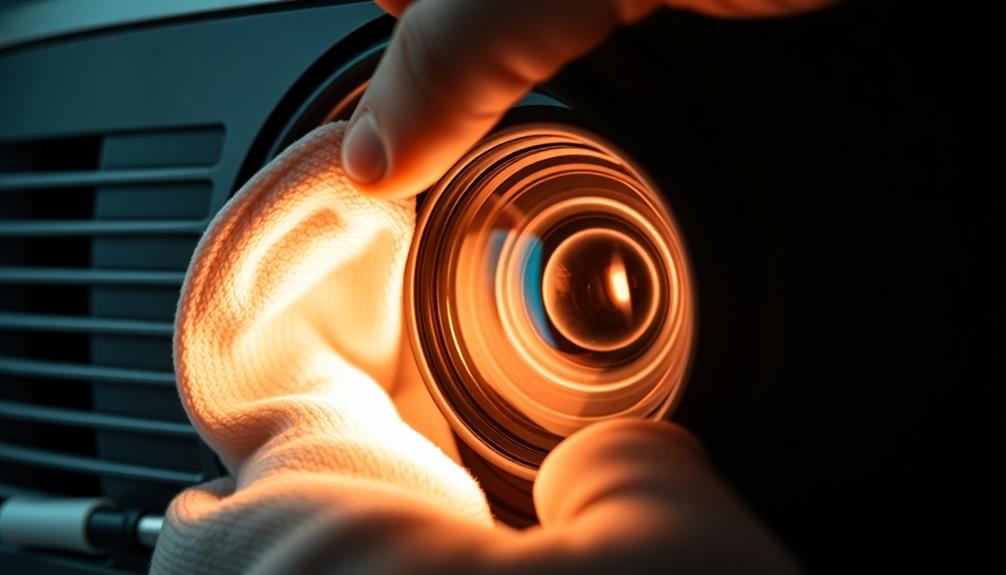
To keep your projection optics in top shape, it's crucial to implement lens protection techniques and regular maintenance practices.
Using filters and lens caps can greatly enhance image quality and shield your equipment from dust and scratches.
Lens Protection Techniques
When it comes to protecting your projector's optics, implementing effective lens protection techniques is essential.
These methods not only help maintain image quality but also reduce dust accumulation and the need for frequent cleaning.
Here are some practical techniques you can adopt:
- Attach a circular polarizer filter: This enhances image contrast while safeguarding against dust and scratches.
- Use lens caps: When the projector's idle, covering the lens prevents dust from settling, ensuring it remains clean and ready for use.
- Secure filters with double-sided tape: If your lens lacks screw provisions, this provides extra protection against environmental factors.
Regular Maintenance Practices
Maintaining your projector's optics is essential for guaranteeing crisp, clear images and ideal performance. Implementing regular inspections of the lens for dust and smudges helps you maintain image clarity and guarantees peak performance. Establishing light cleaning routines with appropriate materials, like microfiber cloths, can notably reduce the frequency of deep cleaning.
To protect your projector further, consider the following preventive measures:
| Maintenance Practice | Frequency | Benefits |
|---|---|---|
| Regular Inspections | Weekly | Detects dust/smudges early |
| Light Cleaning Routines | Bi-weekly | Maintains image clarity |
| Preventive Measures | Monthly | Protects lens from dirt |
| Professional Servicing | Annually | Addresses internal dust issues |
Keeping your projector in a dust-free environment and storing it with the lens cap on when not in use minimizes dirt accumulation on the optics. Finally, scheduling professional servicing for internal cleaning when necessary guarantees that any internal dust issues are resolved without risking damage to your projector. By following these practices, you'll enhance your projector's longevity and performance.
Importance of Filters
Filters play an essential role in protecting your projector's optics and enhancing image quality. By using the right filters, you can markedly reduce glare and improve contrast, making your viewing experience much more enjoyable.
Regular maintenance of these filters not only preserves their effectiveness but also safeguards the underlying projection optics from potential damage.
Consider these key benefits of using filters:
- Circular polarizer filters can boost image contrast, ensuring vibrant colors and sharp details.
- Lens caps, when your projector's not in use, keep dust away, minimizing cleaning frequency and maintaining image clarity.
- Double-sided tape can secure filters on lenses that don't have a screw provision, preventing any slippage during operation.
Implementing high-quality filters is vital for prolonging the lifespan of your projector. They help maintain consistent image quality, ensuring you get the most out of your investment.
Remember to inspect and clean your filters regularly to keep them functioning at their best. By prioritizing these practices, you'll enhance your overall projection experience while protecting your valuable equipment.
Common Cleaning Mistakes
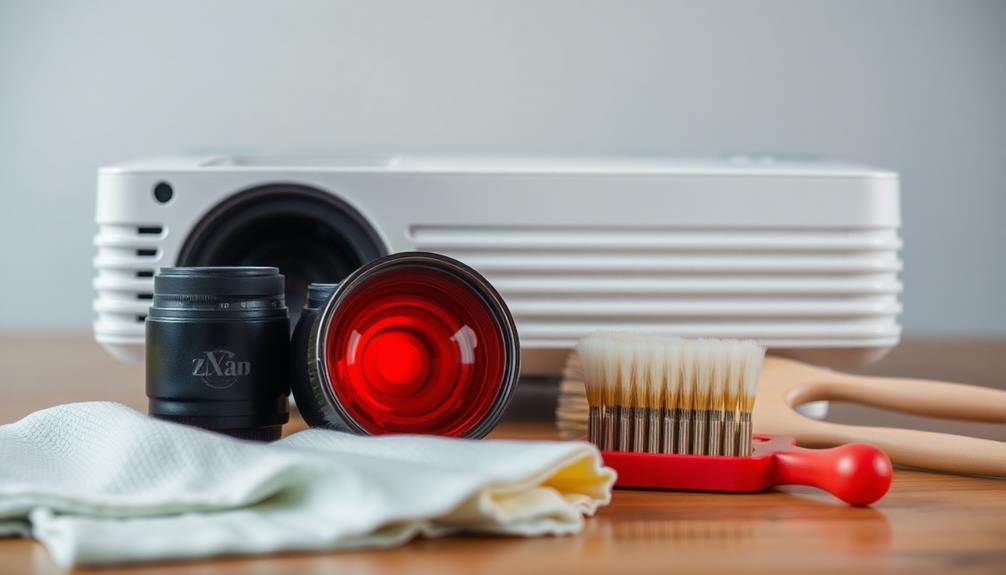
Many projector owners make common cleaning mistakes that can harm their lenses and affect image quality. One major error is using cotton balls with liquids; they can leave behind fibers that stick to the lens, potentially causing scratches. Instead, opt for microfiber cloths that won't shed.
Blowing air directly from your mouth onto the lens is another mistake. This can introduce saliva, which may damage the lens coating. Remember, that coating is essential for ideal performance.
Frequent and rigorous cleaning can backfire too. Excessive contact with the lens surface often leads to more haze rather than clarity, resulting in scratches. When you apply cleaning solutions, always wet the cloth first; dry materials can be abrasive and lead to damage.
Dust Impact on Performance

Even a thin layer of dust on your projector lens can impact image quality, making it crucial to keep the lens clean.
While minor dust particles mightn't be noticeable, excessive dust accumulation can blur your images and diminish contrast, leading to a subpar viewing experience.
Regular cleaning is essential for maintaining peak performance.
Consider the effects of neglecting dust on your projector:
- Reduced image clarity: Dust can obscure details and make images look hazy.
- Increased lens damage risk: Using harsh cleaning methods on heavily soiled lenses can harm delicate coatings.
- Frequent cleaning necessity: Letting dust build up will force you to clean more often, disrupting your setup.
Troubleshooting Image Issues
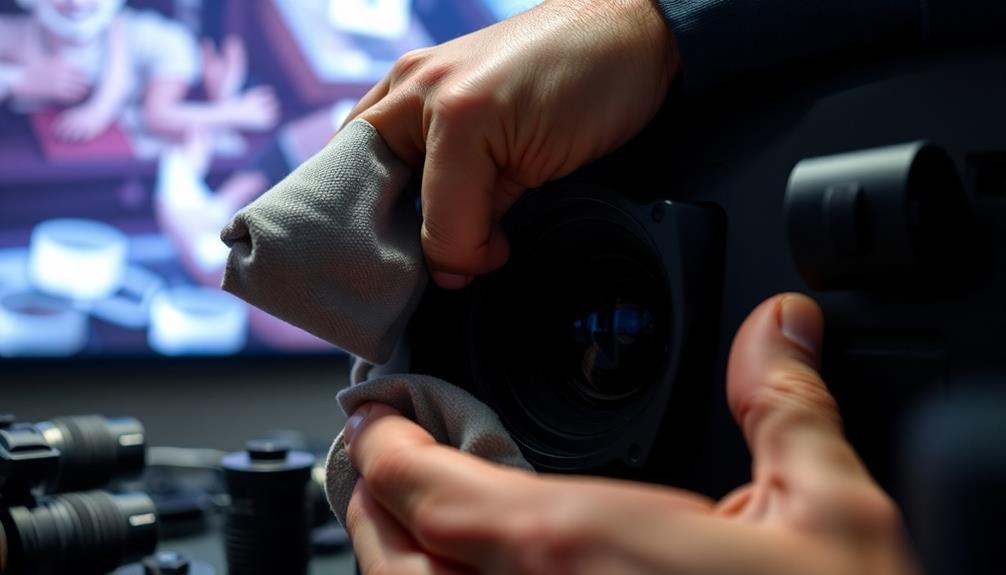
Neglecting lens cleaning can lead to various image issues that may affect your viewing experience. For instance, blurred images often indicate lens contamination or internal dust buildup. When you notice these symptoms, it's essential to act quickly, as they can require professional servicing for thorough cleaning.
If your projector exhibits contrast loss or image distortion, you should check for internal dust and particles that may not be visible on the lens surface. Regular inspections of both the lens and internal components can help you identify potential issues early, preventing significant degradation of image quality.
When cleaning, always use appropriate cleaning techniques. Excessive or harsh methods can damage the lens coating and worsen image clarity. Use a microfiber cloth and specialized lens cleaner to avoid scratching the surface.
For persistent lens issues, consulting the manufacturer's guidelines is wise. If the problems continue, seeking professional assistance guarantees proper maintenance and prevents further complications.
Professional Servicing Recommendations
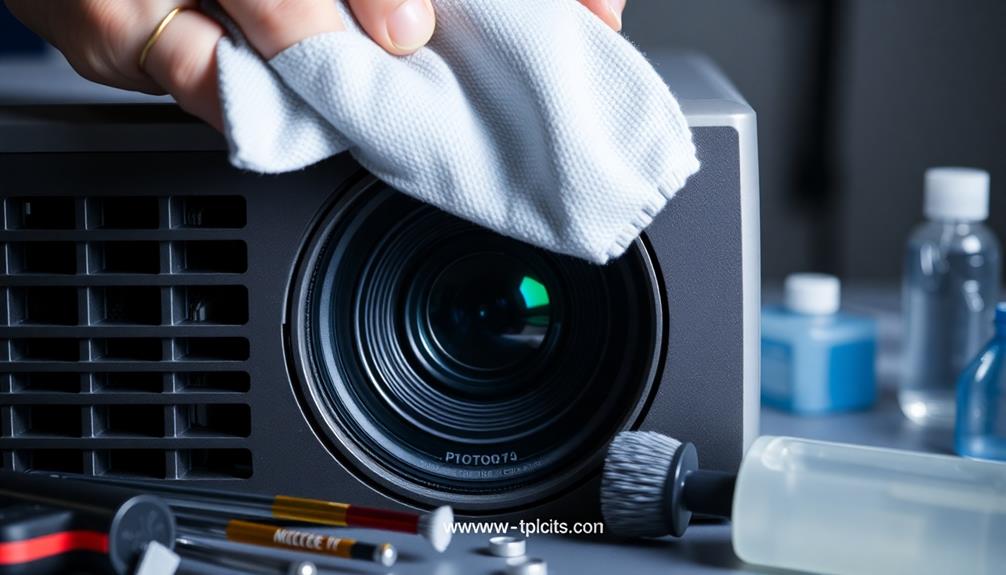
When it comes to maintaining your projector, professional servicing is often a necessity for keeping it in top shape. Scheduling a professional maintenance visit at least once a year can greatly enhance your projector's ideal performance and image quality.
Technicians specialize in cleaning internal components and can reach areas that are tricky for you, such as:
- The optical engine, where dust accumulation can degrade performance.
- Internal lens assemblies, which require careful handling to avoid damage.
- Other hard-to-access areas that might harbor dust and dirt.
Regular inspections by professionals can catch wear and tear before they lead to bigger issues, ensuring that your projector remains functional and efficient.
These experts are equipped with the right tools and knowledge to provide thorough maintenance, extending your projector's lifespan. With their help, you can maintain high-quality image output and enjoy a seamless viewing experience.
Don't overlook the importance of professional servicing—it's a key investment in preserving the performance and longevity of your projector.
Frequently Asked Questions
How to Improve Projector Image Quality?
To improve projector image quality, regularly adjust settings like brightness and contrast, guarantee proper resolution, and keep the projector's lens clean. Use high-quality content and maintain an ideal viewing environment for the best experience.
How Do You Clean Projector Optics?
To clean projector optics, power off and unplug it first. Use compressed air to remove dust, then gently wipe the lens with a soft cloth and lens cleaner, avoiding harsh chemicals or abrasive materials.
Do Projectors Require Maintenance?
While you might think projectors run endlessly, they actually need maintenance. By cleaning them regularly, you'll guarantee they perform at their best, extending their lifespan and enhancing your overall viewing experience greatly.
What Is the Preventive Maintenance of a Projector?
To prevent issues, regularly inspect your projector for dust, keep it in a clean environment, and store it properly. Following manufacturer guidelines for cleaning and scheduling professional servicing will enhance its longevity and performance.
Conclusion
By regularly cleaning and maintaining your projector, you're not just preserving image quality; you're enhancing your viewing experience. Think of it this way: a well-maintained projector is like a sharp eye, delivering vivid details and crisp colors. Don't let dust and neglect dim your visuals. Commit to routine care, and your projector will reward you with stunning performances for years to come. So, why wait? Start your maintenance journey today and see the difference for yourself!
Hi, I’m Dominique. I love movies and want everyone to have the best home cinema experience possible. That’s why I started 1home Theatre Projector. We help people build their home cinema system using the latest technology and news on laser tv and all-around home entertainment.
We’re a small team of movie buffs (and experts) who are passionate about giving our readers the best advice and information possible. So whether you’re just starting out or you’re looking to upgrade your home cinema system, we’ve got you covered!
Home Cinema
How to Use a Projector for Immersive Audio Visualization
You’ll discover how to transform audio into captivating visuals using a projector, but wait until you see the stunning effects you can create!

To use a projector for immersive audio visualization, start by selecting a projector with over 3000 lumens for clear images. Connect it to your laptop or audio source using HDMI or VGA cables, then adjust the focus and keystone settings for peak viewing. Run audio processing software like Processing to analyze audio signals with Fast Fourier Transform (FFT). Create dynamic visuals that respond to the audio frequencies using VPT for projection mapping. Verify your visuals sync with the audio for an engaging experience. With these steps, you'll reveal new dimensions in your audio experience, and there's so much more to explore next!
Key Takeaways
- Choose a projector with over 3000 lumens and position it correctly for optimal image size and clarity.
- Connect your projector to a laptop using HDMI or VGA, and select the appropriate input source.
- Use software like Processing, VPT, and libraries for real-time audio analysis and visualizations.
- Perform FFT analysis on audio to create visually dynamic projections that respond to frequency changes.
- Test various projection surfaces and utilize masking techniques for clear, engaging visuals in sync with audio.
Setting Up Your Projector
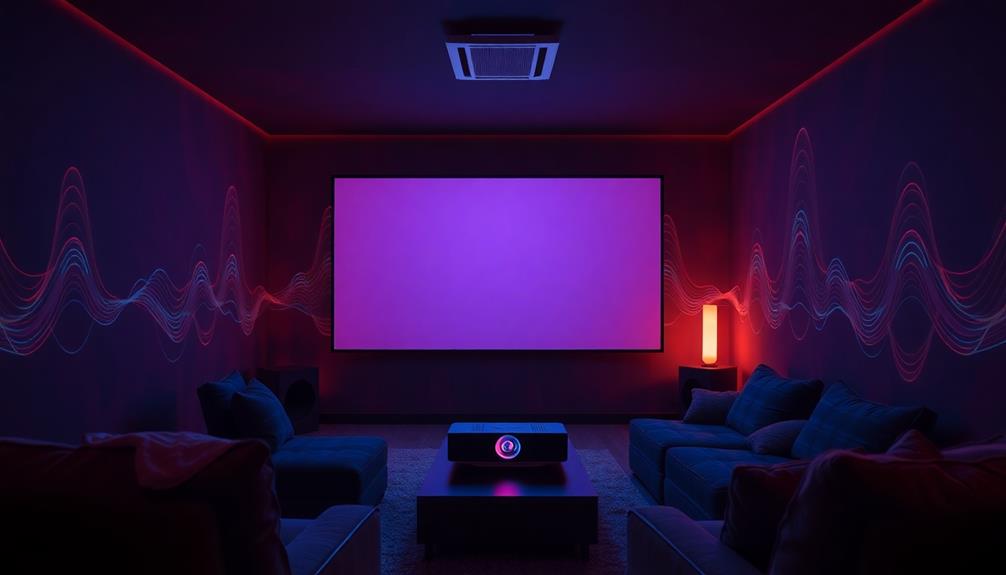
Setting up your projector is essential for achieving the best audio visualization experience. First, choose a projector with sufficient brightness—ideally over 3000 lumens—so you can enjoy clear visuals, even in well-lit spaces.
Position your projector at the right distance from your projection surface, following the manufacturer's throw ratio guidelines to guarantee ideal image size and clarity.
Next, connect your projector to your laptop or audio source using the appropriate HDMI or VGA cables. Don't forget to select the correct input source on the projector to get things started.
Once connected, adjust the focus and keystone settings to create a sharp, rectangular image. This step helps compensate for any tilt or angle from your projection surface.
Essential Hardware and Software

To kick off your audio visualization project, you'll need the right hardware and software that work seamlessly together. Start with essential hardware: a portable laptop or desktop to run the necessary software and process audio input effectively. You'll also need a projector; choose one based on your size and power preferences for projecting visuals onto the prepared boxes that represent audio spectrum bands.
Here's a quick overview of the key components you'll need:
| Component | Purpose | Notes |
|---|---|---|
| Portable Laptop/Desktop | Runs software and processes audio input | Confirm it has enough power |
| Projector | Projects visuals onto the boxes | Select based on size preferences |
| Music Player | Plays audio for analysis | iTunes works well for this |
Don't forget to prepare your visuals by sourcing boxes from local supermarkets and painting them white for ideal projection. Optionally, you can integrate a microphone for live audio input. Essential software tools include Processing with controlP5, netP5, and oscP5 libraries, and VPT (version 7) for projection mapping. These elements will help you create an immersive experience that engages your audience visually and audibly.
Audio Processing Techniques
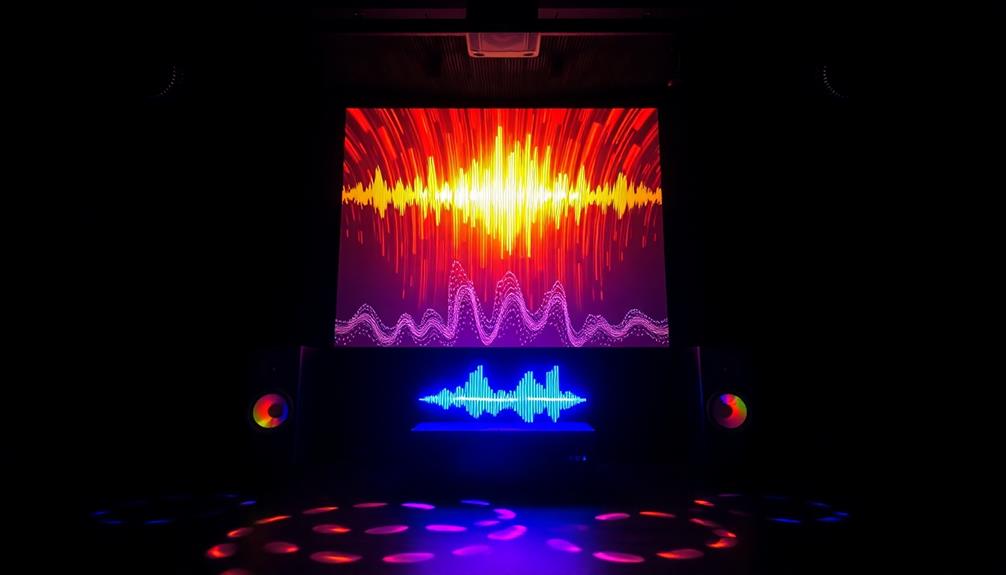
Once you've got your hardware and software in place, it's time to focus on audio processing techniques that will bring your visuals to life.
Begin by implementing the Fast Fourier Transform (FFT) algorithm to analyze audio signals. This tool breaks down sound into its frequency components, allowing for real-time visualization that reacts to what you're playing. To capture all audio output from your laptop, set the Stereo Mix as your default recording device.
Next, utilize OSC (Open Sound Control) protocols to transmit audio analysis data to your projection mapping software, like VPT. This integration enables dynamic visual representation, making your show more engaging.
To enhance interactivity, consider using libraries such as controlP5, netP5, and oscP5 in Processing. These resources help you develop visualizations that respond instantly to changes in the audio spectrum.
Creating Dynamic Visuals

Dynamic visuals are essential for immersing your audience in an audio-visual experience that captivates and energizes. To start creating dynamic visuals, perform Fast Fourier Transform (FFT) analysis on your audio samples. This process isolates frequency bands, allowing for real-time visualization that reacts to the audio input.
Using projection mapping software like VPT, design layers that correspond with these frequency bands. This guarantees your visuals change in sync with the sound, providing an engaging experience.
Implement a user interface that enables frequency monitoring and gain control, giving you precise adjustments for even more compelling visuals.
Consider creating multi-layered projections for each box in your setup. This approach allows for distinct visual representations of different audio frequencies across various surfaces. It adds depth and complexity to your display.
Overcoming Common Challenges
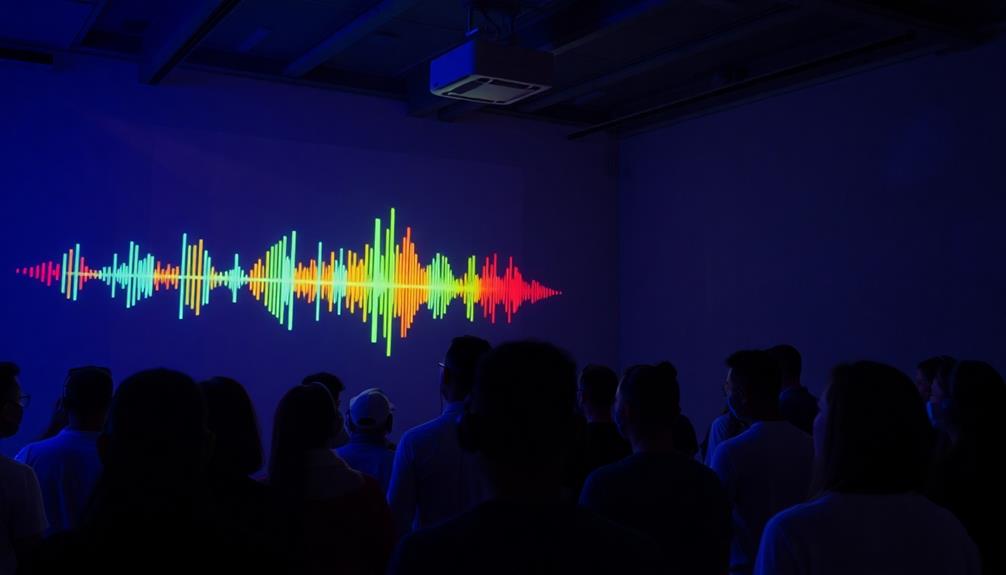
Creating enchanting visuals can present a range of challenges, especially when using stacked boxes for projection. You might find overlapping projections leading to visual confusion, which can really undermine your immersive experience. To overcome this, guarantee each layer is clearly defined.
I've tried using masking techniques to isolate projections on each box, and it's a game changer for enhancing visual clarity. Additionally, utilizing high contrast ratios can help achieve deeper blacks and brighter whites, making your visuals pop even more, essential for detailed image rendering in dark scenes the role of contrast ratio.
Consider simplifying your setup by using 2D projection surfaces like boards; they offer easier management compared to complex 3D shapes. Plus, implementing easing algorithms can help create smooth shifts in your visuals, preventing abrupt fades that distract from the audio experience.
To elevate your projection quality, don't hesitate to test various materials for your surfaces. The right material can greatly improve visibility and react better to lighting conditions.
Here are three challenges you might face:
- Overlapping projections causing confusion
- Abrupt shifts disrupting immersion
- Poor visibility due to inadequate materials
Frequently Asked Questions
How Do You Use a Projector With a Sound System?
To use a projector with a sound system, connect your projector to the audio source, verify compatibility, and adjust settings for ideal clarity. Position it properly to achieve the best visual experience alongside your audio.
Is There a Program That Can Visualize Audio?
Yes, programs like Processing, VPT, and Blaze 3 can visualize audio. They analyze sound frequencies, creating dynamic visuals that respond to music, enhancing your experience with engaging, interactive audio-visual installations. You'll love the results!
How to Get Sound When Using a Projector?
Imagine sound waves dancing through the air. To get sound when using a projector, set your laptop's audio source correctly, connect external speakers, and guarantee everything's configured for an enchanting auditory experience.
How to Make a Real-Time Audio Visualizer?
To make a real-time audio visualizer, start by analyzing audio frequencies with FFT. Use software like Processing to create visuals that respond dynamically. Finally, guarantee your audio input captures sound accurately for effective visualization.
Conclusion
So, you've mastered the art of turning sound into sight, only to realize that your projector's brighter than your future. As you bask in the glow of your vibrant visuals, remember that each beat doesn't just resonate in the air—it dances across the walls, teasing your senses. Embrace the chaos of colors and sounds, and let your imagination run wild. After all, who needs silence when you can have a symphony of visuals lighting up your world?
Hi, I’m Dominique. I love movies and want everyone to have the best home cinema experience possible. That’s why I started 1home Theatre Projector. We help people build their home cinema system using the latest technology and news on laser tv and all-around home entertainment.
We’re a small team of movie buffs (and experts) who are passionate about giving our readers the best advice and information possible. So whether you’re just starting out or you’re looking to upgrade your home cinema system, we’ve got you covered!
Home Cinema
DIY Projector Control System: Integrating With Smart Home Devices
Automate your DIY projector control system with smart home devices to enhance your viewing experience; discover the endless possibilities that await you.

Integrating a DIY projector control system with your smart home devices enhances your viewing experience greatly. You can automate projector movements using linear actuators and relays for perfect screen alignment. By connecting to a smart home hub like Home Assistant, you gain control over lighting, climate, and audio-visual systems, creating tailored "movie mode" scenes. Use smart lighting and climate control to set the perfect ambiance automatically. Plus, adding security features guarantees peace of mind. If you want to maximize your home cinema setup, there's much more to explore in the steps and setups available.
Key Takeaways
- Utilize linear actuators and relays to automate projector movement for optimal screen alignment in your home theater setup.
- Integrate your DIY projector control with Home Assistant for seamless automation and voice command capabilities.
- Create automation scenes to enhance your viewing experience, such as "movie mode" to dim lights and lower the projector simultaneously.
- Connect smart lighting, climate controls, and audio systems for a cohesive and immersive entertainment environment.
- Ensure security by incorporating smart locks and surveillance cameras to protect your home theater equipment and enhance safety.
Understanding DIY Projector Control

When it comes to understanding DIY projector control, you'll find that automation can greatly enhance your viewing experience. By integrating smart home devices with your projector system, you can create a seamless setup that responds to your needs.
Utilizing components like linear actuators and relays, you can automate the movement of your projector, guaranteeing it adjusts perfectly to your projector screen.
Using a smart home hub like Home Assistant allows you to control your projector through automation systems. With a Fibaro Switch FGS 223, you can schedule operations and control power supply via smart plugs or voice commands.
The addition of a 12v DC linear actuator gives you precise control over the projector's height and position, making adjustments easy and effective.
To elevate your movie nights, consider creating automation scenes that link your projector with smart lights and sound systems. For instance, you can set a "movie mode" that dims the lights and lowers the projector simultaneously, enhancing your viewing experience.
Testing the functionality of your projector lift mechanism guarantees everything operates smoothly, providing you with a reliable home theater setup.
Essential Smart Home Protocols
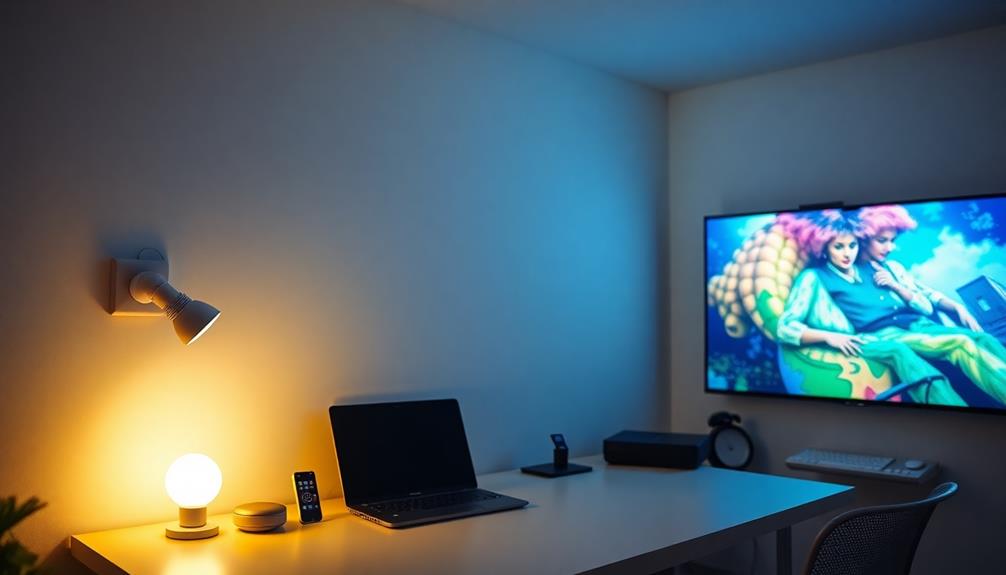
A variety of smart home protocols play an essential role in ensuring your devices communicate effectively. Wi-Fi is the most common choice for smart devices due to its ease of setup and broad compatibility. However, it can drain energy and create connectivity issues when too many devices are connected.
For more efficient communication, consider Zigbee, which operates on a low-energy mesh network. It's perfect for battery-powered devices like sensors and smart bulbs, but it does require a compatible hub for integration with systems like Home Assistant. Additionally, leveraging AI-driven personalization in E-learning can enhance user experience by adapting to individual preferences and needs.
Z-Wave is another reliable option, known for its robust security and longer range. Operating at a lower frequency than Wi-Fi, it minimizes interference, making it ideal for critical devices such as relays and switches.
By integrating these protocols within your smart home system, you can enhance automation and streamline control of your devices.
With Home Assistant, you can connect various smart devices, allowing you to create a cohesive system. This opens up possibilities for voice control, managing smart bulbs, and integrating security systems seamlessly.
Choose the right protocols, and you'll optimize your DIY projector control system and overall smart home experience.
Integrating Audio and Video Systems
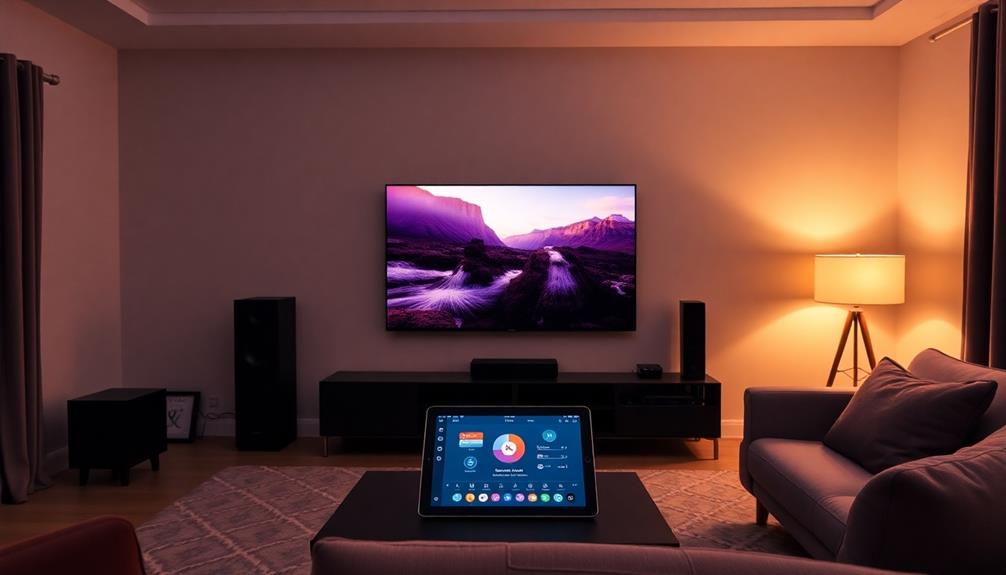
Integrating audio and video systems in your smart home creates a seamless entertainment experience, allowing you to control multiple devices from a single interface.
With the right setup, you can automate your home to enhance your movie nights or game days effortlessly. Utilize smart amplifiers and receivers to enable automatic input selection and volume adjustment based on the content being played, simplifying operation for everyone.
When you're setting up your smart home theater, consider smart lighting solutions that adjust automatically, optimizing your viewing environment based on screen brightness and time of day.
This integration in Home boosts comfort and immersion.
Voice assistants play an essential role in managing these audio and video systems. You can easily control playback, switch sources, and adjust settings hands-free, making it convenient during gatherings or when you're multitasking.
Automating Lighting and Climate
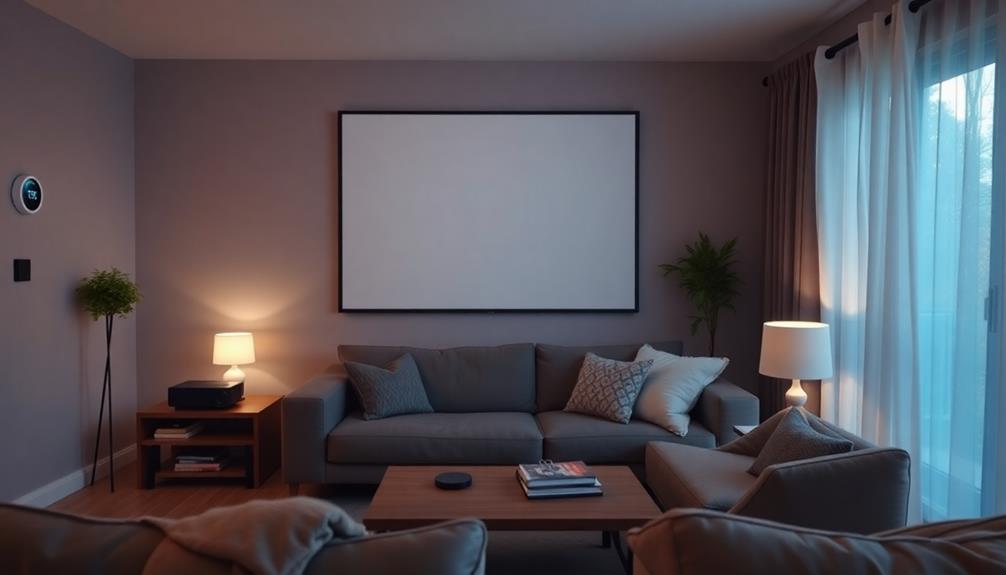
Automating lighting and climate in your home theater can greatly enhance your viewing experience. By incorporating smart bulbs or dimmer switches, you can adjust brightness based on your projector system's needs. This eliminates glare and creates the perfect ambiance.
Smart thermostats can play an essential role, too; they can be programmed to automatically adjust the climate before your movie starts, ensuring you're comfortable throughout the viewing session.
Utilizing motion sensors adds another layer of convenience. These sensors can turn lights on or off as people enter or leave the viewing area, promoting energy savings and a hassle-free environment.
Integrating smart blinds is crucial for controlling natural light levels. You can set them to automatically adjust based on the time of day or specific movie schedules, maintaining a dark atmosphere for your films.
With Home Assistant, you can create automation routines that link projector activation with simultaneous adjustments to your lighting and climate controls. This means when you're ready for movie night, everything falls into place seamlessly, enhancing your overall viewing experience and making it more enjoyable.
Security Features for Home Theaters

When setting up your home theater, security should be a top priority.
Integrating smart locks and surveillance cameras not only controls access but also keeps an eye on your equipment.
Plus, automating your alarm system can provide real-time alerts, ensuring you enjoy your movie nights without worry.
Surveillance Camera Integration
Security is a paramount concern for any home theater enthusiast, and surveillance camera integration offers a robust solution. By incorporating smart surveillance systems, you can enhance the security of your valuable equipment and enjoy peace of mind.
Additionally, ensuring a clean indoor environment with an air purifier can further improve the overall experience in your home theater by reducing allergens and creating a more pleasant space.
Here are some advantages of integrating surveillance cameras:
- Real-time monitoring: Stay updated with live feeds from your home theater.
- Motion detection: Advanced systems, like Reolink Cameras, can detect movement and trigger automated responses.
- Automated alerts: Connect your cameras to Home Assistant for instant notifications on unusual activity.
- Two-way audio: Communicate remotely with anyone in the theater area, adding an extra layer of safety.
Many modern surveillance cameras also feature high-definition video and night vision capabilities, ensuring you can monitor your space effectively, even in low-light conditions.
The combination of these features provides not just security but also convenience, allowing you to automate your home theater experience seamlessly.
With the right setup, you can transform your home theater into a smart home haven, where safety and automation go hand in hand.
Smart Lock Access Control
Integrating smart lock access control into your home theater setup adds an extra layer of protection for your valuable equipment. Smart locks can restrict access to your home theater by requiring authentication, guaranteeing that only authorized individuals can operate the system.
With features like biometric access or keypad entry, you can enhance security and make it more convenient for yourself and trusted guests. Additionally, considering the cost of home security systems can help you find the right balance between securing your home and staying within budget.
As part of your home automation journey, these smart locks offer remote access, allowing you to grant temporary access to visitors while maintaining control over who enters your space. Imagine being able to automatically open and close the door based on your presence or set schedules for movie nights.
Moreover, integration with your existing smart home devices guarantees thorough security. You'll receive alerts and notifications for any unauthorized access attempts, helping you monitor your setup in real-time.
Coupled with a security camera, you can keep an eye on your home theater from anywhere. By incorporating smart lock access control, you'll not only protect your equipment but also elevate your overall home theater experience.
Alarm System Automation
Enhancing your home theater experience goes beyond just the visuals and sound; it's also about ensuring a safe environment. Integrating an alarm system with your home theater can greatly boost home security, providing peace of mind while you enjoy your favorite films.
Here are some effective ways to automate your alarm system:
- Automatic Arming/Disarming: Set your alarm system to auto-arm or disarm based on your projector's operation, ensuring security during movie nights.
- Smart Locks: Use smart locks to restrict access to your home theater equipment, preventing unauthorized entry while you're immersed in a film.
- Motion Sensors: Incorporate motion sensors that trigger alerts or notifications when unusual activity is detected, offering real-time monitoring of the space.
- Automation Scenes: Create automation scenes that activate security cameras and alarms when the projector turns on, establishing a thorough security protocol.
Many home automation platforms, like Home Assistant, facilitate seamless integration of these features, allowing for one-touch activation of multiple security measures.
Troubleshooting and Maintenance Tips
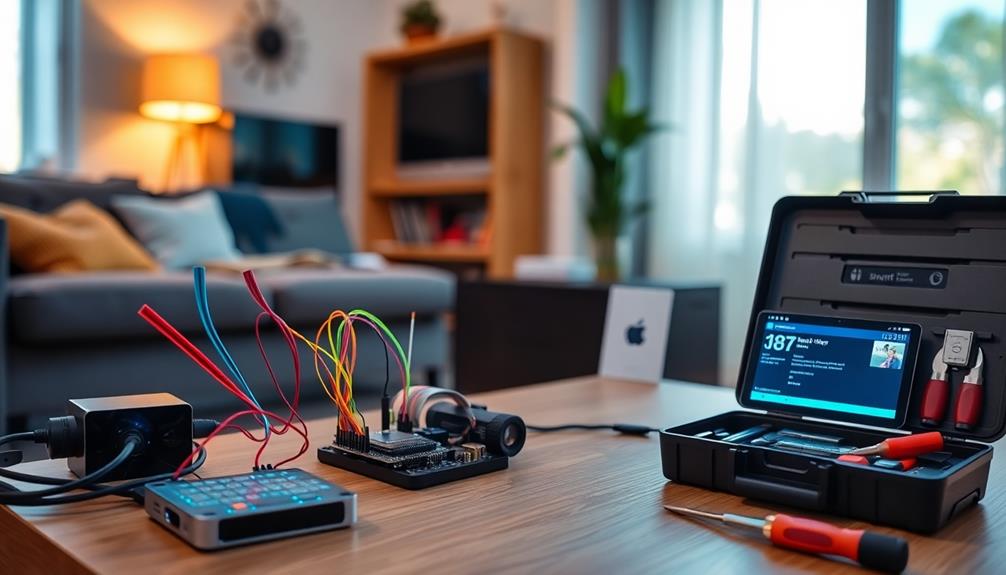
As you set up your DIY projector control system, it's essential to stay on top of troubleshooting and maintenance to guarantee everything runs smoothly.
Regularly test the linear actuator and relay functionality to catch any potential issues early in your integration process. Monitoring the temperature around the projector and actuator is important—overheating can lead to performance issues or even damage over time.
Using high-quality cables and connectors is critical for reliable signal transmission. This minimizes friction and guarantees your system operates at its best.
Make it a habit to keep the firmware and software for all your smart home devices updated. This not only enhances overall system stability but also provides you with improved features and security patches.
Document any troubleshooting steps and solutions you encounter. This will create a valuable resource for future maintenance and potential upgrades to your system.
Frequently Asked Questions
Can I Control My Projector With My Smartphone?
Yes, you can control your projector with your smartphone! Many projectors offer Wi-Fi or Bluetooth connectivity, allowing you to use dedicated apps or universal remote apps for easy management, enhancing your viewing experience effortlessly.
What Smart Home Platforms Are Compatible With Projectors?
You'll find several smart home platforms compatible with projectors, such as Google Home, Amazon Alexa, and Apple HomeKit. These systems let you control your projector easily, enhancing your home entertainment experience with seamless integration.
Is Voice Control Available for All Projector Models?
Not every projector model embraces the wonders of voice control. While some offer this delightful feature, others stick to traditional methods. You'll need to check individual specifications to see what suits your needs best.
How Do I Set up Scheduling for My Projector?
To set up scheduling for your projector, access its settings menu, find the scheduling option, and enter the desired times. Don't forget to save your settings to guarantee it operates as planned!
Can I Use Multiple Projectors in One Smart Home System?
Imagine a symphony of colors dancing across your walls. Yes, you can harmonize multiple projectors in one smart home system. Just verify they're compatible and configure them to work together seamlessly for an immersive experience.
Conclusion
Incorporating a DIY projector control system into your smart home elevates your entertainment experience. As the saying goes, "a stitch in time saves nine," so investing a little effort now will pay off later with seamless integration and automation. By connecting your audio, video, lighting, and climate systems, you create a personalized oasis that responds to your needs. With these tips, you'll enjoy a fantastic home theater while ensuring everything runs smoothly and efficiently.
Hi, I’m Dominique. I love movies and want everyone to have the best home cinema experience possible. That’s why I started 1home Theatre Projector. We help people build their home cinema system using the latest technology and news on laser tv and all-around home entertainment.
We’re a small team of movie buffs (and experts) who are passionate about giving our readers the best advice and information possible. So whether you’re just starting out or you’re looking to upgrade your home cinema system, we’ve got you covered!
-

 Beginners Guides3 months ago
Beginners Guides3 months agoHow to Connect Set Top Box to Home Theatre and TV
-
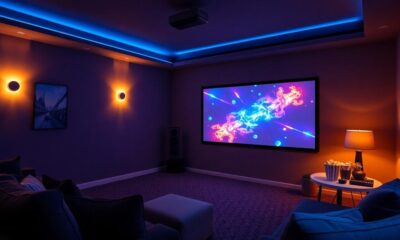
 Home Cinema3 months ago
Home Cinema3 months agoHow to Use a Projector & 10 Tips to Set up Your Projector Perfectly
-
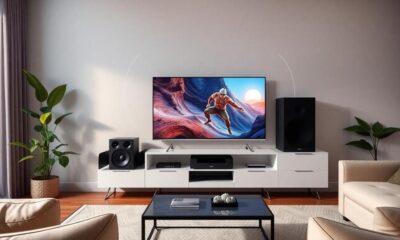
 Beginners Guides3 months ago
Beginners Guides3 months agoHow Do I Connect My Home Theater to My TV Wirelessly?
-

 Home Cinema2 months ago
Home Cinema2 months agoProjector Optics Cleaning and Maintenance: Preserving Image Quality
-
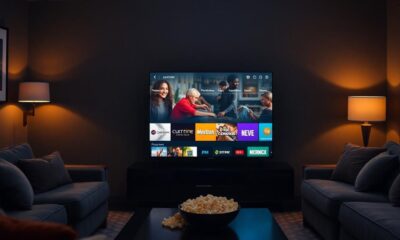
 Beginners Guides3 months ago
Beginners Guides3 months agoHow to Watch Curzon Home Cinema on My LG TV
-
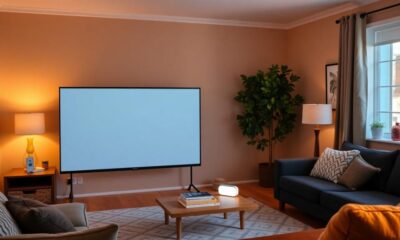
 Home Cinema2 months ago
Home Cinema2 months agoDIY Projector Control System: Integrating With Smart Home Devices
-
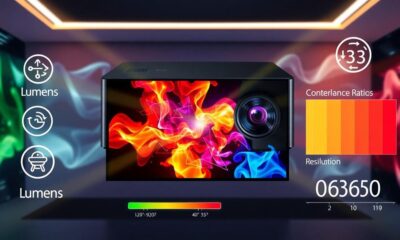
 Home Cinema3 months ago
Home Cinema3 months agoUnderstanding Projector Specifications: Lumens, Contrast Ratio, and Resolution Explained
-

 Home Cinema3 months ago
Home Cinema3 months agoThe Environmental Impact of Projectors Vs. TVS
